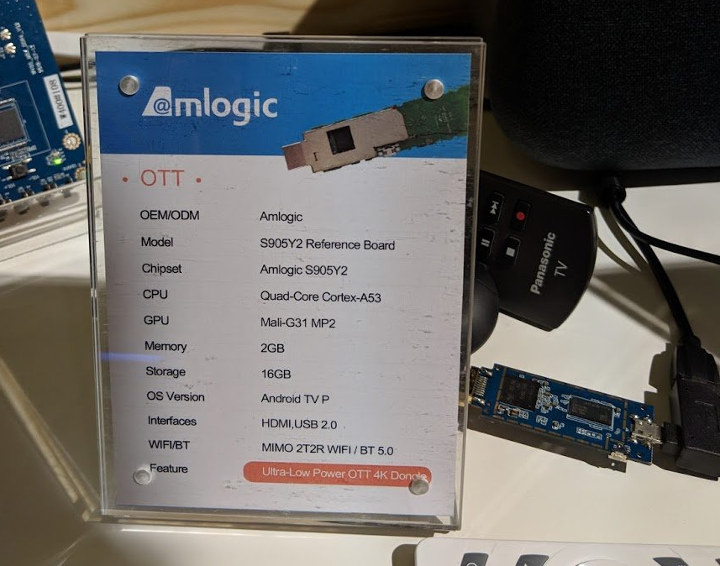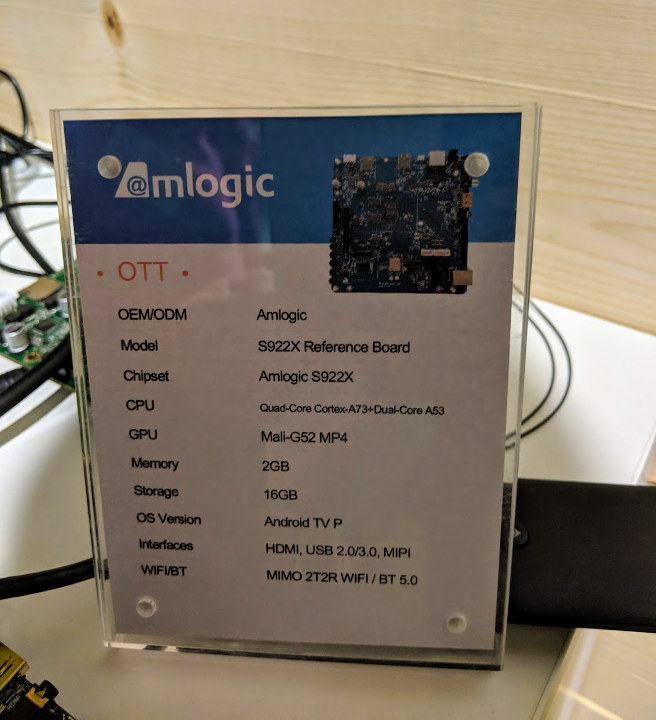At the very beginning of this year, we published an Amlogic roadmap showing Amlogic S922 next gen CPU/GPU, and S905X2 quad core Cortex A53 processors, but so far we still had limited information, and as per Amlogic own roadmap S922 was still at the definition stage, so exact specifications may have been expected to change at the time.
The company showcased some exciting new solutions at IBC 2018 with three reference boards based on new Amlogic S905Y2, S905X2, and S922 processors all running Android TV 9 “Pie”. “Android TV Rumors” was apparently at the event and posted some photos on twitter.
Amlogic S905Y2 Reference Board
 Amlogic S905Y2 processor is using the same old quad-core Cortex A53 configuration, but features a more modern Arm Mali-G31 MP2 GPU. The reference board is designed for OTT 4K HDMI dongles, and comes with 16GB storage, 2GB RAM, USB 2.0 interface, as well WiFi 2T2R, and Bluetooth 5.0 connectivity.
Amlogic S905Y2 processor is using the same old quad-core Cortex A53 configuration, but features a more modern Arm Mali-G31 MP2 GPU. The reference board is designed for OTT 4K HDMI dongles, and comes with 16GB storage, 2GB RAM, USB 2.0 interface, as well WiFi 2T2R, and Bluetooth 5.0 connectivity.
Amlogic S905X2 Reference Board
 We already knew most details about Amlogic S905X2 from the roadmap, with the quad core Cortex A53 processor also featuring a Mali-G31 MP2 “Dvalin” GPU, but it’s the first time I see the reference board which also comes with 2GB RAM, 8 or 16 GB storage, HDMI, USB 2.0 & 3.0 ports, and apparently the same WiFi + Bt 5.0 module. Amlogic S905X2 reference board is designed for 4K OTT TV boxes, instead of the stick form factor used in the S905Y2 reference design.
We already knew most details about Amlogic S905X2 from the roadmap, with the quad core Cortex A53 processor also featuring a Mali-G31 MP2 “Dvalin” GPU, but it’s the first time I see the reference board which also comes with 2GB RAM, 8 or 16 GB storage, HDMI, USB 2.0 & 3.0 ports, and apparently the same WiFi + Bt 5.0 module. Amlogic S905X2 reference board is designed for 4K OTT TV boxes, instead of the stick form factor used in the S905Y2 reference design.
Amlogic S922X Reference Board
Amlogic S922X will likely be the most interesting model, as it’s the first Cortex A7x processor from Amlogic. The SoC is equipped for a total of six cores including four Arm Cortex A73 cores and two Cortex A53 cores, and a Mali-G52 MP4 GPU. The board showcased at IBC 2018 comes with 2GB RAM, 16GB storage, HDMI and MIPI (display? camera?) interfaces, USB 2.0/3.0 port, and WiFi + Bluetooth 5.0 connectivity.
Bear in mind those are reference boards, so they’ll be used by Amlogic customers for development, but not sold for the general public. Shenzhen Wesion appears to be working on Khadas development boards based on some of the new Amlogic processors, but no details are publicly available at this stage.
Android TV 9 was not only showcased on development boards based on upcoming processors however, as SDMC demonstrated Android TV 9 running on a TV box powered by Amlogic S905X with just 1GB RAM, as the OS was optimized by Amlogic to run smoothly with a low amount of RAM as possible.
Via AndroidPC.es, Redneckerz, and TheGuyUK

Jean-Luc started CNX Software in 2010 as a part-time endeavor, before quitting his job as a software engineering manager, and starting to write daily news, and reviews full time later in 2011.
Support CNX Software! Donate via cryptocurrencies, become a Patron on Patreon, or purchase goods on Amazon or Aliexpress





